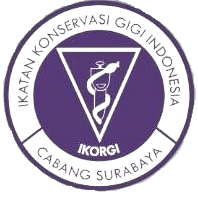Effect of Hydrogel Epigallocatechin-3-Gallate (EGCG) to the Number of Fibroblast Cell Proliferation in the Perforation of Wistar Rat Tooth Pulp
Downloads
Background: Pulpitis can occur because the deep cavity preparation and it causes increasing of NO levels. Perforated teeth require direct pulp capping (DPC) treatment. The current standard DPC material is calcium hydroxide. However, several studies have found weaknesses of calcium hydroxide that can affect the success of DPC treatment and new, more biocompatible materials are needed. Epigallocatechin-3-gallate (EGCG) in green tea has many benefits, including antioxidant, anticolagenase, anticancer, anti-inflammatory and has the ability of radical scavenging to clean NO so that pulp healing can occur better by increasing the number of fibroblast cells that play a role in wound healing. Purpose: To determine the concentration of hydrogel EGCGs that are effective in increasing the number of fibroblast cell proliferation in the dental pulp perforation of Wistar rats. Method: This research is a laboratory experimental study with a randomized post test only control group design. Samples used in the study were 24 male Wistar rats which were divided into four groups, namely the negative control group and the treatment group were given EGCG 60 ppm, 90 ppm, and 120 ppm and were decapitated on the 7th day after treatment. The maxilla and the 1st molar were taken and decalcified, to process the HPA reading with HE staining. Observations were made using a microscope with a magnification of 400x. Results: There were significant differences in the treatment groups with 60 ppm and 90 ppm hydrogel hydrogels on the results of the Oneway ANOVA difference test (p <0.05). Conclusion: The concentration of hydrogel EGCG which is effective in increasing fibroblast cell proliferation is 90 ppm.
Nirwana I. Aktivitas Ekstrak Buah Delima (Punica granatum linn) Sebagai Material Pulp Capping terhadap Ekspresi IL-6, IL-10, TGFB-1, MMP-1, dan Kolagen Tipe I pada gigi Perforasi Mekanik. Universitas Airlangga; 2012: 1.
Fatimatuzzahro N, Heniastuti T, Handajani J. Respon inflamasi pulpa gigi tikus Sprague Dawley setelah aplikasi bahan etsa ethylene diamine tetraacetic acid 19% dan asam fosfat 37%. Dental Journal (Majalah Kedokteran Gigi). 2013;46(4):5.
Landén N, Li D, Ståhle M. Transition from inflammation to proliferation: a critical step during wound healing. Cellular and Molecular Life Sciences. 2016;73(20):3862.
Popowics T, Fehrenbach M. Illustrated dental embryology, histology, and anatomy. St. Louis (Mo.): Elsevier Saunders; 2016: 169
Kunarti S. TGF-β1 as the Trigger of Pulp Fibroblast Proliferation. Folia Medica Indonesiana. 2008;44(2):67.
Torabinejad M, Walton R. Endodontics. 4th ed. Philadelphia, Pa.: Saunders; 2009: 49-54
Brizuela C, Ormeño A, Cabrera C, Cabezas R, Silva C, Ramírez V et al. Direct PulpCapping with Calcium Hydroxide, Mineral Trioxide Aggregate, and Biodentine in Permanent Young Teeth with Caries: A Randomized Clinical Trial. Journal of Endodontics. 2017;43(11):1776.
Chu C, Deng J, Man Y, Qu Y. Green Tea Extracts Epigallocatechin-3-gallate for Different Treatments. BioMed Research International. 2017;2017:1-3.
Ismiyatin K, Soetoyo A, Wahluyo S, Mukono I. Therapeutic Efficacy of Topical Epigallocatechin-Gallate as a New Therapeutic Strategy for Inhibition of Pain Conduction on Rat Models with Acute Pulpal Inflammation. International Medical Device and Technology Conference. 2017;:107-110.
Delicia D.Biokompatibilitas Epigallocatechin-gallate Dalam Gel polyethylene Glycol terhadap Sel Fibroblas Gingiva Manusia. Airlangga University; 2017: 43.
Kurnia PA, Ardhiyanto HB, Suhartini. Potensi ekstrak teh hijau (Camellia sinensis) terhadap peningkatan jumlah sel fibroblas soket pasca pencabutan gigi pada tikus Wistar. e-Jurnal Pustaka Kesehat. 2015; 3: 122–7.
Khan, S.; Hashmi, G. S. Histology and Functions of Connective Tissues: A Review Article. University J. Dent. Sci. 2015, 1, 1–2.
Legeay S, Rodier M, Fillon L, Faure S, Clere N. Epigallocatechin Gallate: A Review of Its Beneficial Properties to Prevnt Metabolic Syndrome. Nutrients. 2015;7(7):5443-5468.
Sutini. Produksi Epigallocatechin Gallate Pada Kultur In Vitro Kalus Camellia Sinensis Sebagai Kandidat Pangan Fungsional. 2015;:92-100.
Kucera O, Mezera V, Moravcova A, Endlicher R, Lotkova H, Drahota Z et al. In VitroToxicity of Epigallocatechin Gallate in Rat Liver Mitochondria and Hepatocytes. Oxidative Medicine and Cellular Longevity. 2015;2015:2.
Wu Y, Choi H, Kang Y, Kim J, Shin J. In Vitro Study On Anti-Inflammatory Effects Of Epigallocatechin-3-Gallate-Loaded Nano- And Microscale Particles. International Journal of Nanomedicine. 2017;12:7007-7013.

CDJ by Unair is licensed under a Creative Commons Attribution 4.0 International License.
1. The journal allows the author to hold the copyright of the article without restrictions.
2. The journal allows the author(s) to retain publishing rights without restrictions










